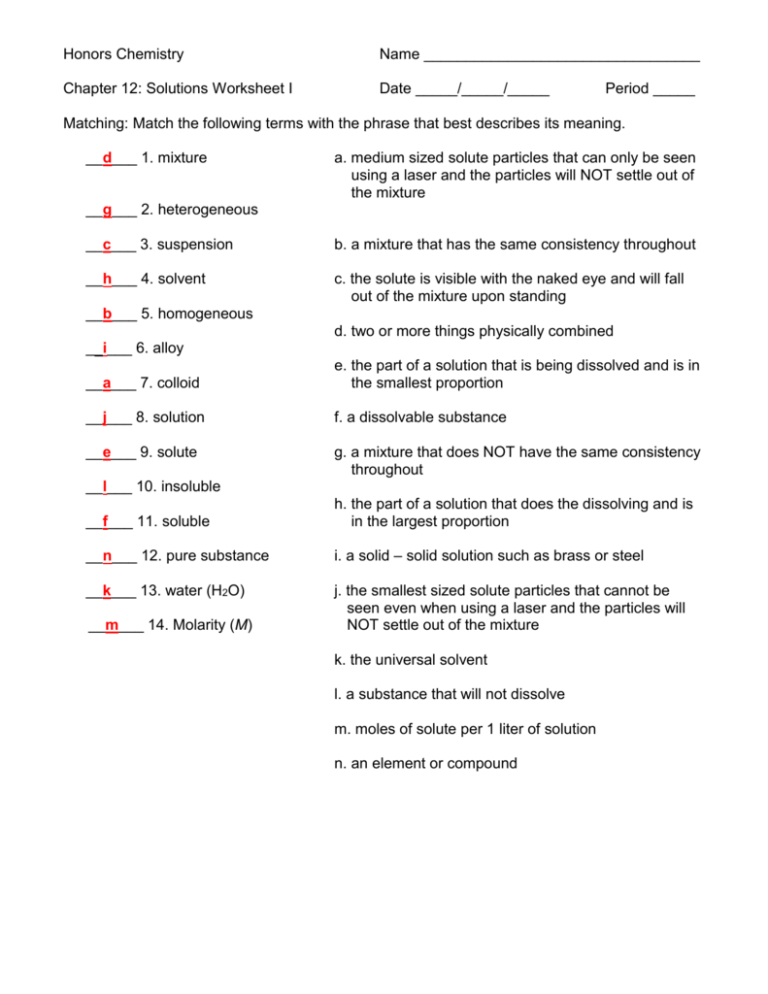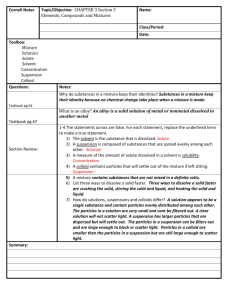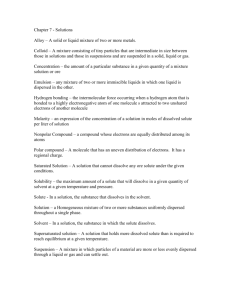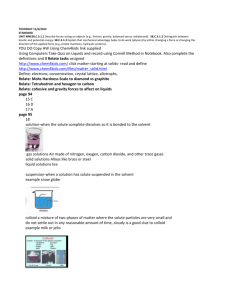Chemistry
advertisement

Honors Chemistry Name _________________________________ Chapter 12: Solutions Worksheet I Date _____/_____/_____ Period _____ Matching: Match the following terms with the phrase that best describes its meaning. __d___ 1. mixture a. medium sized solute particles that can only be seen using a laser and the particles will NOT settle out of the mixture __g___ 2. heterogeneous __c___ 3. suspension b. a mixture that has the same consistency throughout __h___ 4. solvent c. the solute is visible with the naked eye and will fall out of the mixture upon standing __b___ 5. homogeneous d. two or more things physically combined __i___ 6. alloy __a___ 7. colloid e. the part of a solution that is being dissolved and is in the smallest proportion __j___ 8. solution f. a dissolvable substance __e___ 9. solute g. a mixture that does NOT have the same consistency throughout __l___ 10. insoluble __f___ 11. soluble h. the part of a solution that does the dissolving and is in the largest proportion __n___ 12. pure substance i. a solid – solid solution such as brass or steel __k___ 13. water (H2O) j. the smallest sized solute particles that cannot be seen even when using a laser and the particles will NOT settle out of the mixture __m___ 14. Molarity (M) k. the universal solvent l. a substance that will not dissolve m. moles of solute per 1 liter of solution n. an element or compound Completion: Use the following word bank to fill in the correct responses to the given questions. solution suspension solute solvent dissolve suspension insoluble solubility precipitate soluble concentrated saturated unsaturated alloy colloid dilute water 1. What term is used to describe a substance dissolving? soluble 2. What is a solid – solid solution of two or more metals called? alloy 3. A mixture in which the particles are so small that they will not reflect the “light” from a laser is called solution . 4. A solution that contains a large amount of solute per amount of solvent is called a concentrated solution and is said to be strong. 5. What is the term that is used to describe a solid being formed when two or more liquids are mixed together? precipitate 6. When a solution is made, what is the smaller portion of the solution called? In other words, what is the part that is being dissolved called? solute 7. A solution that contains as much solute as it can hold at a given temperature is called saturated . 8. When a solution is made, what is the larger portion of the solution called? In other words, what is the part that is doing the dissolving called? 9. A mixture in which the particles settle out upon stand is called solvent suspension The particles in the mixture can be seen with the naked eye. 10. If a substance will NOT dissolve it is said to be insoluble . 11. A solution that will hold more solute is said to be unsaturated . 12. A solution that contains a small amount of solute per amount of solvent is called a dilute solution and is said to be weak. . 13. A mixture in which the particles can only be seen with a laser and do NOT settle out upon standing is called a colloid . 14. The amount of solute that can be dissolved in a solvent at a given temperature is described as the solutes solubility . 15. Due to the fact that so many substances dissolve in water , it is called the universal solvent. Completion: Explain how each of the following would affect the equilibrium. H2O AgNO3(s) + 22 kJ/mole AgNO3(aq) a. Heating the solution – adding heat affects the side that absorbs energy and causes the reaction to shift away. The reaction shifts to the right. b. Removing solid silver nitrate – removing the solid causes the reaction to shift to the side that the solid is being removed from. It causes the reaction to shift to the left. c. Cooling the solution – cooling the solution indicates that energy is being removed from the side that energy is involved. It causes the reaction to shift to the left d. Adding solid silver nitrate – adding solid affects the side that solid is listed and causes the reaction to shift away from that side. It causes the reaction to shift to the right. Calculations: Show all work for the following calculations. 1. Calculate the molarity, molality, and mass percent of acetic acid, C2H3O2H, in a solution composed of 14.1 g of acetic acid and 250 g of water with a final solution volume of 260 mL. 14.1 g C2H3O2H 1 mole C2H3O2H = 0.235 mole C2H3O2H 60.06 g C2H3O2H 0.235 mole C2H3O2H = 0.90 M 0.26 L 0.235 mole C2H3O2H = 0.94 m 0.25 Kg 14.1 g C2H3O2H x 100 = 5.4 % 260 g 2. How many grams of C2H5OH are required to prepare 25 mL of a 0.400 M solution? 0.025 L C2H5OH 0.400 moles C2H5OH 1 L C2H5OH 46.08 g C2H5OH moles C2H5OH = 0.46 g C2H5OH 3. The level of vitamin C (C6H8O6) in blood is about 0.2 mg per 100 mL. What is the concentration of vitamin C in blood? 0.2 mg C6H8O6 1 g C6H8O6 1000 mg C6H8O6 1 mole C6H8O6 176.14 g C6H8O6 = 1 x 10-6 mole C6H8O6 1 x 10-6 mole C6H8O6 = 1 x 10-5 M C6H8O6 0.1 L C6H8O6 4. What is the normality of a solution in which 45.32 grams of Ca(OH)2 is dissolve in 90 mL of water? (Assume the density of the water and the density of the solution are both 1.000 g/mL) 45.32 g Ca(OH)2 1 mole Ca(OH)2 74.10 g Ca(OH)2 = 0.6116 mole Ca(OH)2 90 mL H2O 1.000 g H2O 1 mL = 90 g + 45.32 g = 140 g solution 140 g solution 1 mL solution 1 L solution 1.000 g 1000 mL solution = 0.14 L solution 0.6116 mole Ca(OH)2 = 4.4 M Ca(OH)2 0.14 L Ca(OH)2 2 eq x 4.4 M Ca(OH)2 = 8.8 N Ca(OH)2 5. Calculate the number of moles of Ca(OH)2 in 150.0 mL of a 0.500 M solution. 0.1500 L Ca(OH)2 0.500 moles Ca(OH)2 1 L Ca(OH)2 0.0750 moles Ca(OH)2








